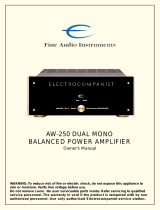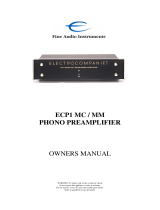Page is loading ...

AW 180
Monaural class A Power Amplifier
Owner's Manual
EN
ENGLISH

2
ENG
Welcome to the world of Electrocompaniet!
We thank you for choosing an Electrocompaniet high-end product.
At Electrocompaniet we are relentlessly focused on developing
audio equipment that is capable of bringing the fabulous experi-
ence of the concert hall into the very heart of your home.
Our aim when developing and testing new products is to ensure
that the wonderful richness of tone and every nuance of feeling
and emotion of a piece of music is delivered to you just as the artist
intended.
We continually strive to give you the very best musical listening
experience available whatever your preferred musical genre.
Sincerely yours
Mikal Dreggevik
CEO

3
ENG
The design features of Ampliwire 180 Mono
After the Electrocompaniet 25 watt amplifier had established a new standard for
transistor amplifiers, research was undertaken to find ways to make the amplifier
even better, and to extend its highly musical sound quality to more powerful amplifier
designs. The engineers at Electrocompaniet were not satisfied by only reducing the
commonly recognized types of distortion to low levels. They recognized that distor-
tion appears in many forms, and that distortion was still audible in listening tests even
when conventional categories of distortion were at astonishingly low levels.
Traditionally, designers increased feedback to make a larger portion of the output
signal control the amplifiers response. Our listening tests showed us that simply
applying more feedback was not the answer. In fact, as one kind of distortion went
down, other parameters would be adversely affected, leading to an overall degrada-
tion of sound quality. We knew that the other conventional design approach of
eliminating feedback completely was not the answer either, because this would
cause high distortion levels, and as a result would produce a “woolly” sound.
The answer to the dilemma was found in a novel approach to feedback theory.
We developed a feedback concept that allowed local feedback to be applied around
individual stages of the amplifier circuit. This approach allowed us to avoid the sonic
disadvantages of overall feedback from output to input. The concept was further
developed to reduce phase and interphase distortion between stages of the amplifier
as well. We were able to concentrate the loop feedback on the stages of the amplifier
where it resulted in audible improvement.
Stability margins were also expanded because feedback no longer affected the
frequency response. The use of this concept of individual gain blocks - complex in
design but simple in function allowed us to reduce distortion to minute values in all the
products.
The amplifier is divided into two separate sections or gain blocks. The input block is a
transconductance amplifier without overall feedback. This avoids large output current
being fed back to the input, and mixed with the minute input signal. The output block
is a transresistance amplifier with parallel feedback. This is done to prevent higher
frequencies than the feedback loop can handle, from entering the loop. An approach
like this will prevent Transient Inter modulation Distortion (TIM) and Slewing Induced
Distortion (SID), eliminating the need for an extremely wide bandwidth.
All stages work in Class A with an efficiency of less than 0,1%.
The power supply of the AW180 consists of one 650 VA toroidal transformer.
Furthermore, the power supply consists of a 60.000 micro farad reservoir divided into
six 10.000 micro farad capacitors in parallel with 4,7 and 0,1 micro farad
polycarbonate and polypropylene capacitors.

4
ENG
Unpacking the amplifier:
Immediately upon receipt of the amplifier, inspect the carton for possible damage
during shipment. If the carton is visibly damaged, a claim must be filed with the carrier
as soon as possible.
Unpack the unit carefully, and please do remember to save all packaging materials for
future shipment. The carton and packaging have been designed to offer the safest
possible protection when transporting your amplifier.
The content of the carton is as follows:
•
2 pcs. Electrocompaniet Ampliwire AW 180 Mono
•
2 pcs. AC power cord
•
1 pc. Owner's Manual
•
1 pc. Spare fuse, 10.0 AT slow-blow 5x20mm (120V AC)
6.3 AT slow-blow 5x20mm (220V AC)
The actual spare fuse is located inside the AC 3 pin receptacle.

5
ENG
Connecting the AW 180 (illustration page 10):
Connecting to mains
Check that the mains voltage printed on the rear panel of the amplifier corresponds
with the line voltage in the territory were you intend to use your amplifier.
How to avoid damages
A good operating practice is to turn off all equipment before any connections or dis-
connection’s are made. Do not under any circumstances connect or disconnect equip-
ment when power is turned on. If you insist on connecting or disconnecting
while power is turned on, you should be aware that this can generate a large tran-
sient when inserting the plug. This could damage both the speakers and the amplifier.
The rear panel
The rear panel of the AW 180is equipped with loudspeaker terminals and two sets of
XLR input sockets, one XLR female socket and one XLR male socket for each channel.
Inputs
For optimal performance, the AW180 should be used in balanced mode with
balanced XLR cables. (ie. the preamplifier should have balanced outputs.)
Link
This XLR output can be used to link more amplifiers together and the link output signal
will be exactly the same than on the input. Do not short these outputs to ground or
together.
XLR input and link cable configuration ( illustration page 9)
XLR input: 1 = ground 2 = positive 3 = negative
Make sure pin 2 and pin 3 are not interchanged, as this will cause the system to
operate out of phase, with very poor bass response as a result.
Single ended operation
For single ended operation use an RCA to XLR adapter ( Electrocompaniet ECP5XLR).
Connect ECP5XLR to the XLR input.
Connect the RCA interconnect to the input on the ECP5XLR

6
ENG
Operating instructions:
How to turn on your system
You should always turn on your equipment in this order: Signal source devices (CD,
tuner, etc) and preamplifier are turned on first. Allow 30 seconds of preheating before
you turn on your power amplifier. When turning your system off, you should start by
switching off your power amplifier, then the preamplifier, and finally your signal source
devices After switching on the power amplifier, there will be a 5 seconds delay before
the speakers are connected. This will prevent large turn on/off transients to reach the
speakers.
Replacing a blown main fuse ( page 8)
Always remove the AC cord from the Inlet. The main fuse is located inside a small
drawer in the AC inlet of the unit. If, for some reason the fuse blows, turn the unit off,
and remove the AC cord from the inlet. Open the drawer with a small screwdriver and
remove the broken fuse. The spare fuse is located in the hole in front of the main fuse.
Push the new fuse gently out of the hole, and place it in correct position (where the
blown fuse was removed). Push the drawer gently back to the closed position, connect
the power cord and turn the unit on. Never replace a blown fuse with other values
than printed on the unit.
Never replace a blown fuse with other values than printed in this manual:
10.0 AT slow-blow 5x20mm (120V AC)
6.3 AT slow-blow 5x20mm (220V AC)
Warning:
The amplifier will be warm. Due to the high class A operating point used in the
Electrocompaniet design, it is normal that the amplifier feels warm. Proper ventilation
will be needed, and the amplifier should not be covered in. A good rule is to allow
1 - 2 inches of air sidewise, and 2 - 3 inches above the amplifier. If placing the ampli-
fier on the floor, be aware of carpets that can obstruct the ventilation underneath the
amplifier.

7
ENG
Technical Specifications AW180:
The following technical data were measured on randomized test objects and
are typical data.
Amplifier section
Main voltage 120 V / 240 V. Clipping point of the amplifier is set to a level where
total harmonic distortion (THD) is 0.2 %.
•
Output Impedance: (20 Hz - 20 kHz) 0,008 Ohm
•
RCA (single) input impedance: 220 kOhm
•
XLR (balanced) input impedance: 110 kOhm
•
Input sensivity for rated output: 1 V
•
Max. peak current > 100 A
•
THD (measured at 1 kHz half power 8 Ohm) < 0,001 %
•
THD (measured at 1 kHz -1 dB, 8 Ohm) < 0,001 %
•
Noise (measured with both inputs shorted):
400 Hz - 30 kHz : 90 μV
10 Hz - 30 kHz : 100 μV
Rated output power
10 % change in line voltage will give app. 20 % change in output power.
•
8 Ohm 250 W
•
4 Ohm 380 W
•
2 Ohm 625 W
Power consumption (no load or signal) 115 W
Dimensions
•
Width 215 mm / 8.5 inches
•
Depth 470 mm / 18.5 inches
•
Height 288 mm / 11.3 inches
•
Weight 22kg. / 48.4 lbs.
*The manufacturer reserves the right to alter these specifications without further notice.

8
ENG
TYPE : AW 180
Manufactured by:
Electrocompaniet, Norway
I 0
Replacing a blown main fuse:
10.0 AT slow-blow 5x20mm (120V AC)
6.3 AT slow-blow 5x20mm (220V AC)

9
ENG
TYPE : AW 180
Manufactured by:
Electrocompaniet, Norway
I 0
XLR
female input
On/Off
switch
Power socket
Spare fuse
XLR
male input
Speaker
terminals
output
Rear panel overview:
10.0 AT slow-blow 5x20mm (120V AC)
6.3 AT slow-blow 5x20mm (220V AC)

10
ENG
TYPE : AW 180
Manufactured by:
Electrocompaniet, Norway
I 0
TYPE : AW 180
Manufactured by:
Electrocompaniet, Norway
I 0
INPUT
+ -
LINK
INPUT
+ -
LINK
BI-WIRING
Connection diagram
TYPE : AW 180
Manufactured by:
Electrocompaniet, Norway
I 0
TYPE : AW 180
Manufactured by:
Electrocompaniet, Norway
I 0
INPUT
+ -
LINK
INPUT
+ -
LINK

11
ENG
If Service is needed
Your dealer will have all relevant information regarding the service centers in your area, and will
ensure that your unit is serviced with minimum delay. It is our general policy to have your unit
returned to you within five working days. This is an average time, and can vary locally, depend-
ing on the workload at that particular service station. If, for some reason, there are no service
facilities available in your country, please ship the unit to the following address:
Electrocompaniet as,
Breivikveien 7,
N-4120 Tau,
Norway
Web: www.electrocompaniet.no
Service department: www.electrocompaniet.no/support
The end user is responsible for all shipping charges, insurance, re-importation and duty charges.
When shipping a product to the factory for service, always include the following:
1. A sales slip or other proof of purchase if repair is claimed under warranty.
2. A proforma invoice with value of goods, stating that the AW 180 is returned to Norway
for repair.
3. An accompanying letter describing faults, symptoms, or problems with the unit.
4. Always ship the unit in its original carton and packaging material to prevent damage
in transit.
Electrocompaniet will not cover damages incurred in transit. If you require further information
concerning the operation of the unit, or if you have any questions related to service, please do
not hesitate to contact your dealer or your national distributor.

Warning!
To avoid risk of fire or electric shock, do not expose this appliance to rain or moisture.
Verify line voltage before use.
Do not remove cover. No user serviceable parts inside.
Refer servicing to qualified service personal.
The warranty is void if the product is tampered with by non-authorised personnel.
Use only authorized Electrocompaniet service center.
LOCAL DEALER
DEALER
STICKER
HERE
Rev.2 - April 2018
Made in Norway
www.electrocompaniet.no
/


